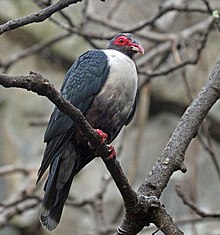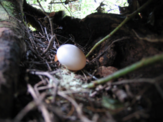
Wallace's fruit dove is a species of a bird in the pigeon family Columbidae. The name commemorates the British naturalist Alfred Russel Wallace. It is a rather large, long-tailed fruit dove with a length of 24–28 cm (9.4–11.0 in) and has been described as "one of the most beautiful" fruit doves. The forehead and crown are dull crimson, the lower face and throat are white, and the rest of the head, breast, neck, and upper back are pale bluish-grey. The wings and lower back are green and the belly is orange, separated from the chest by a white band. Both sexes look similar, but females have less extensive red on the head and a greenish tinge to their grey parts.

The elegant imperial pigeon, also known as blue-tailed imperial-pigeon, is a large pigeon, with upperparts mainly dark blue-green in colour with an iridescent sheen. Head, neck and underparts are mostly pale grey, with red-brown undertail coverts.

The Bornean stubtail is a species of bird in the cettiid warbler family Cettiidae. It is endemic to the island of Borneo, where it inhabits forest floors and undergrowth in montane forests at elevations of 750–3,150 m (2,460–10,330 ft). It is a small, short-tailed warbler, measuring 9.5–10 cm (3.7–3.9 in) in length and having an average mass of 10.4 g (0.37 oz). The tops of the head and the upperparts are brown, with whitish underparts that turn grey at the sides of the breast and the flanks. The supercilium is long and buffish-brown, with an equally long dark grey eyestripe and a thin yellow eye-ring. Both sexes are similar.

The island bronze-naped pigeon, also known as the São Tomé bronze-naped pigeon or São Tomé pigeon, is a species of bird in the pigeon family, Columbidae. It is endemic to the Gulf of Guinea, where it is found on the islands of São Tomé, Príncipe, and Annobón. It inhabits rainforest, secondary forests, and plantations at elevations of up to 1,668 m (5,472 ft), although it is more common at lower elevations. A small, darkish pigeon, it has a total length of 28 cm (11 in). Adult males have slate-grey heads and upper backs, blackish-grey wings, backs, and tails, buffy-white throats, ashy-grey breasts and bellies, and rufous vents. The back of the neck and upper back are glossy pink or green, while the wings have a green tinge to them. Females are similar, but have browner undersides, duller and less glossy upperparts, and more rusty-orange outer tail feathers.

The white-bellied imperial pigeon is a species of bird in the pigeon family Columbidae. First described by the French ornithologist Charles Lucien Bonaparte in 1854, it is endemic to Indonesia, where it is found on Sulawesi, Buton, Taliabu, Togian, and Peleng. It inhabits primary forest, dense secondary forest, and isolated areas of hill forest. A large pigeon with a long tail, it measures 42.5–51.5 cm (16.7–20.3 in) long and weighs 510 g (18 oz) on average. Males are mainly green, with pale-grey heads and bellies, chestnut vents, and a pale grey tail band, along with a red orbital ring. Females are nearly identical, but have darker grey areas in their plumage.

The black imperial pigeon, also known as the Bismarck imperial pigeon, is a species of bird in the pigeon family, Columbidae. First described by English zoologist Philip Sclater in 1878, it is endemic to the Bismarck Archipelago, where it mainly inhabits rainforest and cloud forest in mountain areas above 500 m (1,600 ft). It is a large, heavily built imperial pigeon, with a length of 38–43 cm (15–17 in) and a weight of 661–665 g (23.3–23.5 oz). Adults are almost entirely black, except for the dark chestnut undertail coverts, the silvery-grey underside of the tail, and a pale grey scaly pattern on the wings and back. Both sexes look alike. Juveniles differ from adults in having paler undertail coverts.

The Papuan mountain pigeon is a species of bird in the pigeon family, Columbidae. It is found in the Bacan Islands, New Guinea, the D'Entrecasteaux Islands, and the Bismarck Archipelago, where it inhabits primary forest, montane forest, and lowlands. It is a medium-sized species of pigeon, being 33–36 cm (13–14 in) long and weighing 259 g (9.1 oz) on average. Adult males have slate-grey upperparts, chestnut-maroon throats and bellies, whitish breasts, and a pale grey terminal tail band. The lores and orbital region are bright red. Females are similar, but have grayish breasts and grey edges to the throat feathers.
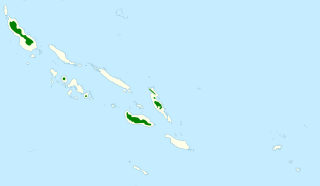
The pale mountain pigeon is a species of bird in the pigeon family Columbidae. It is endemic to the Solomon Islands archipelago, where it inhabits old-growth and secondary montane forest. It is a medium-size pigeon with an average length of 38 cm (15 in) and a weight of 310–385 g (10.9–13.6 oz). The head and neck are whitish-grey, the belly and lower breast are buffy-pink, and the vent and undertail coverts are pale grey. The upperparts are smoky-grey with darker fringes on the mantle and wing coverts. Both sexes look similar, but there can be large variation in individual appearance.

The white-headed fruit dove is a species of bird in the pigeon family Columbidae. It was described by the English ornithologist John Gould in 1856, and the specific name eugeniae honours the French empress Eugénie de Montijo. Adults of the species have white heads, a purplish-red breast patch, a grey shoulder patch, olive-green upperparts, greenish underparts with a blue tinge, and a yellowish vent. Juveniles have green heads with the white restricted to the forehead and upper throat, a much smaller grey shoulder patch, and the red breast patch restricted to the centre of the breast.

The crested cuckoo-dove is a species of bird in the pigeon family, Columbidae. First described by English zoologist John Gould in 1856, it is endemic to the Solomon Islands archipelago, where it mainly inhabits hill forests at elevations of 500–900 m (1,600–3,000 ft). It is a large and robust pigeon, with a length of 40–42 cm (16–17 in) and a distinctive pale purplish-grey crest. Adults are mainly bluish-grey, with a pale greyish-buff throat, blackish tail, and yellow-tipped reddish bill. Both sexes look alike. Juveniles lack the crest, have darker heads, and have duller wings.

The great cuckoo-dove is a species of bird in the pigeon family, Columbidae. First described by the Dutch zoologist Coenraad Jacob Temminck in 1824, it is found on New Guinea, several surrounding islands, and Wallacea, where it mainly inhabits primary forest and forest edge. It is a large, distinctive pigeon, with a length of 47.5–52.5 cm (18.7–20.7 in) and a weight of 208–305 g (7.3–10.8 oz). In adults, the head, neck, and breast are whitish or blue-grey, the underparts are pale bluish-grey, the upperparts are chestnut-brown, and the outer wings are black. Females differ from males in having more yellowish irises and duller orbital skin. Juveniles are mainly dull grey-brown, with dirty-white throats and bellies.
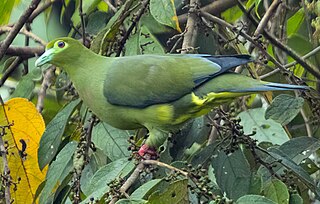
The Sumatran green pigeon is a species of bird in the pigeon family, Columbidae. First described by Dutch zoologist Coenraad Jacob Temminck in 1823, is endemic to Indonesia, where it is found in Sumatra and western Java. It inhabits the canopy of dense hill and montane forest and has been recorded at elevations of 350 to 1,800 m on Sumatra and 600 to 3,000 m on Java. The Sumatran green pigeon is a relatively slender species with a long wedge-shaped tail and an adult length of 29.0–34.1 cm (11.4–13.4 in) in males and 27.7–29.0 cm (10.9–11.4 in) in females. Adult males have a dark green head and body, bright yellow lower belly and undertail-coverts, dark grey tail, and bluish-green unfeathered patches on the face. Adult females are duller and have no grey on the back of the neck, a fainter orange wash on the breast, and no orange markings on the crown or the bend of the wing.

The black cuckoo-dove or black dove, also known as the slaty cuckoo dove, is a species of bird in the family Columbidae. It is endemic to the Lesser Sunda Islands, being found on Timor, Wetar, Rote, and Atauro. It inhabits primary and secondary monsoon forest, eucalyptus forest, and woodlands. It is 38.5 cm (15.2 in) long on average and is mainly dark bluish-gray, lighter on the head and underparts and darker on the wings and tail. It has yellow orbital skin.

Hose's broadbill is a species of bird in the family Calyptomenidae. It was described by the British naturalist Richard Bowdler Sharpe in 1892 and is named after the British zoologist Charles Hose, who collected the holotype of the species. It is 19–21 cm (7.5–8.3 in) long, with females weighing 92 g (3.2 oz) on average and males weighing 102–115 g (3.6–4.1 oz). Males are bright green and have conspicuous black spots on the wings, black markings on the head, blue underparts, black flight feathers, and a large green tuft covering most of the bill. Females have smaller forehead tufts, lime-green underparts with sky blue instead of azure blue on the undertail coverts, and lack black markings on the head, except for a black spot in front of the eye.

Whitehead's broadbill is a species of bird in the family Calyptomenidae. It is endemic to the mountain ranges of north-central Borneo, where it mainly inhabits montane forests and forest edges at elevations of 900–1,700 m (3,000–5,600 ft). It is 24–27 cm (9.4–10.6 in) long, with males weighing 142–171 g (5.0–6.0 oz) and females weighing 150–163 g (5.3–5.7 oz). Males are vivid green and have a black throat patch, black spots on the ear-coverts and back of the neck, and black markings and streaking all over the body. The tails and flight feathers are also blackish. Females are smaller and lack the black markings on the head and underparts. Juveniles look similar to adults but have fewer black markings.
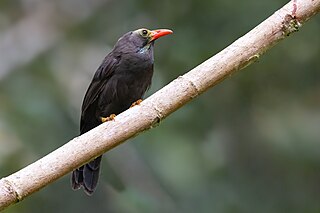
The bare-headed laughingthrush is a species of bird in the Old World babbler family Timaliidae. It is endemic to highland forests at elevations of 750–1,800 m (2,460–5,910 ft) in the mountain ranges of north-central Borneo, along with some outlying peaks. It is 25–26 cm (9.8–10.2 in) long, with both sexes similar in appearance. The head is brownish to greenish yellow and featherless. The area along the lower mandible has a bluish tinge. The rest of the body is dull blackish-brown tinged with grey. Juveniles have more feathers on the head, extending from the forehead to the crown.

The Buru mountain pigeon, formerly also long-tailed mountain pigeon is a species of bird in the pigeon family Columbidae. It is endemic to Indonesia and inhabits montane forest and disturbed lowland forest on Buru. It was formerly considered to be conspecific with the Seram mountain pigeon. It is a medium-sized pigeon 33–38.5 cm (13.0–15.2 in) long, and has a blue-grey crown and neck, darker slate-grey upperparts, and a white to pale buff-pink throat and breast that becomes buff-pink towards the belly. The species is slightly sexually dimorphic, with females being smaller and having more dark red on the breast.

The Seram mountain pigeon is a species of bird in the pigeon family Columbidae that is endemic to the island of Seram in Indonesia, where it inhabits hill forest. It was long considered to be a subspecies of the Buru mountain pigeon, but was split on the basis of differences in appearance. It is a medium-sized pigeon with a buff-pink face and breast, wine-pink underparts, a grey nape, crown, back of neck, and thighs, and dark chestnut belly and underside of the tail.
